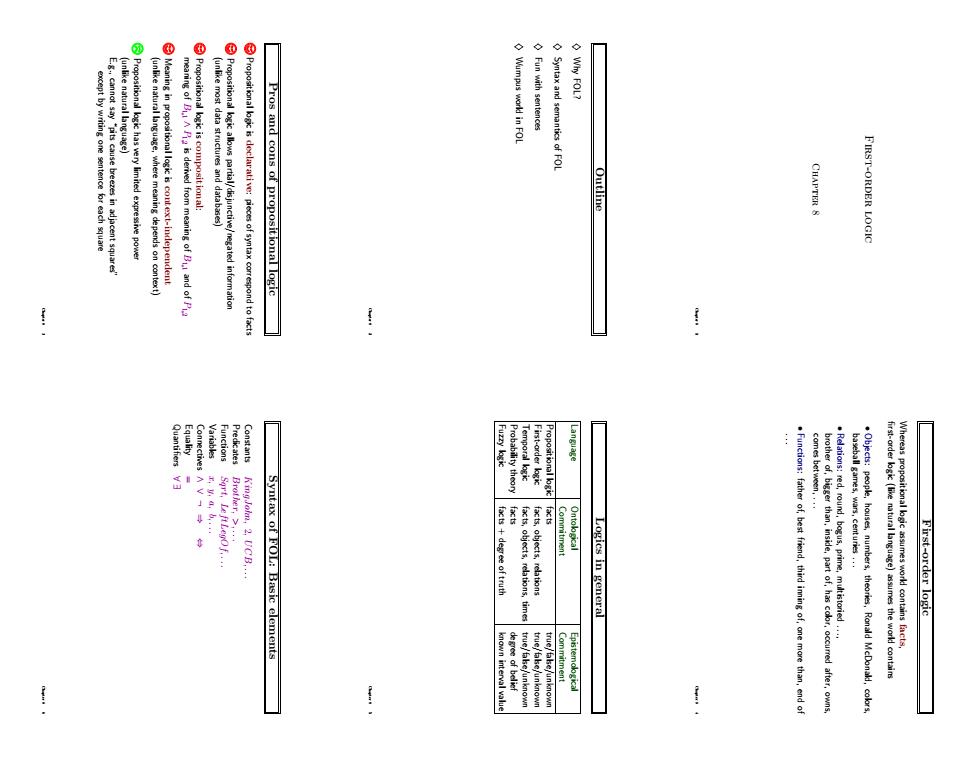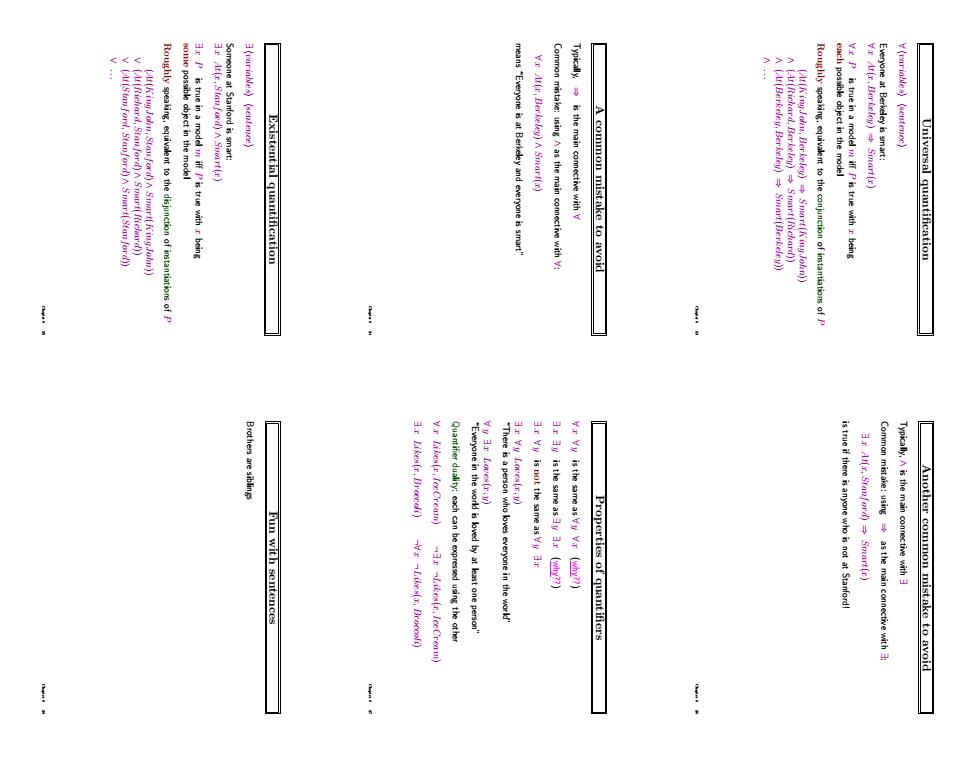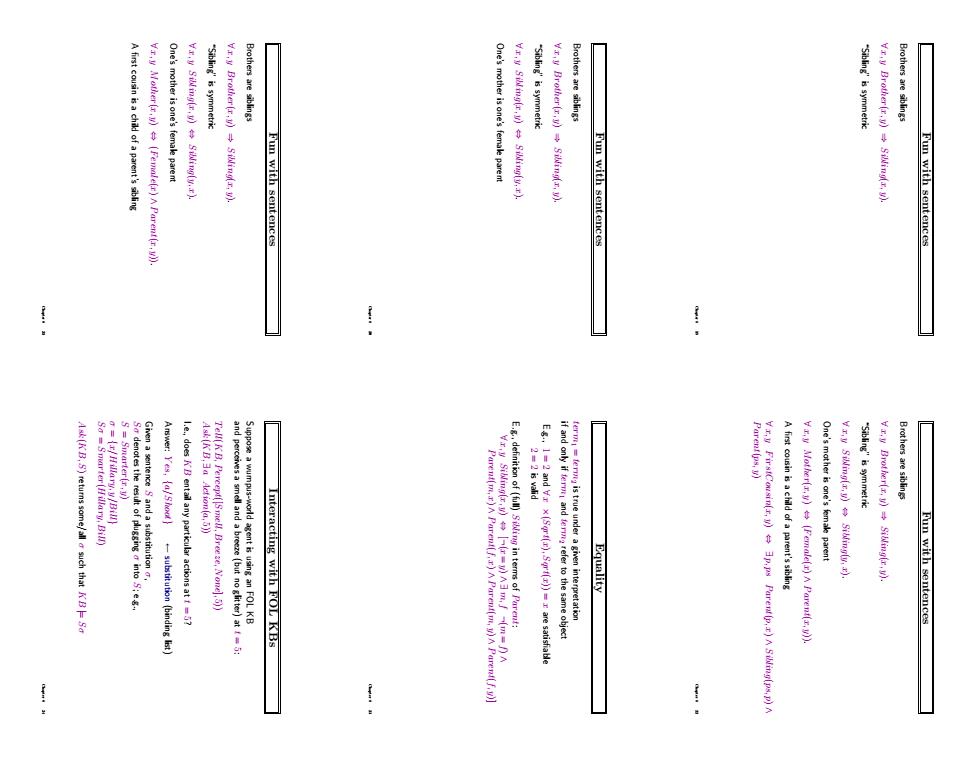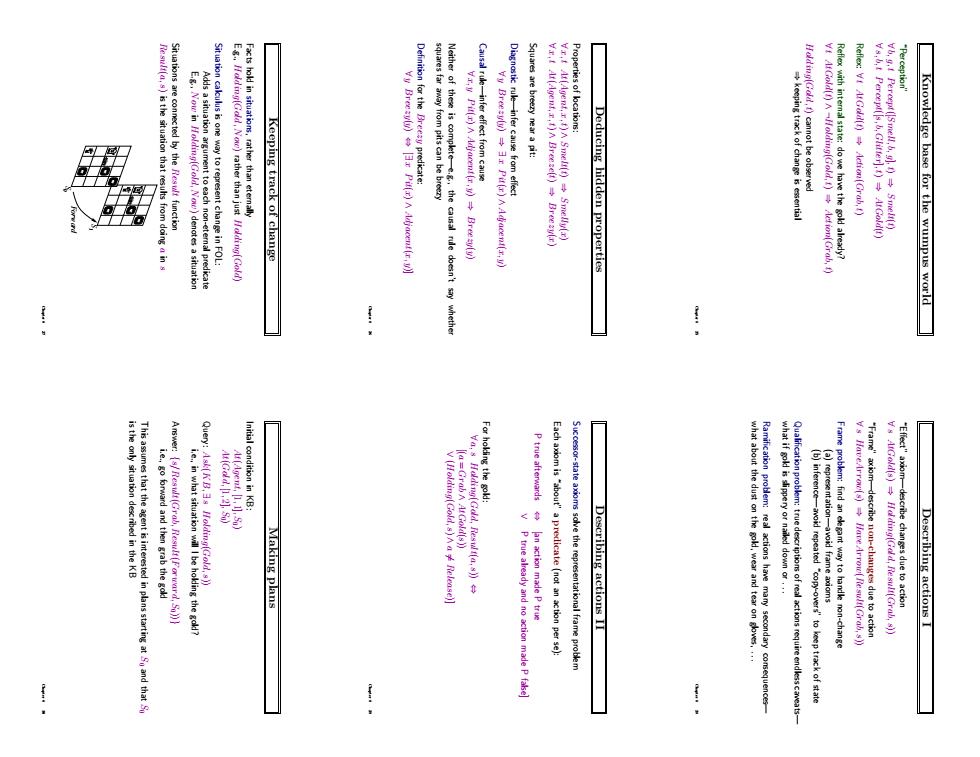
nlike natural lang Why FOL? (unlike natural language,where meaning depends on context) Meaning in propositional logic is context-independent Pros and cons of propositional logic Wumpus work in FOL Fun with sentences Syntax and semantics of FO Outline CHAPTER S FIRST-ORDER LOGK irst-ordergic Language ↓ Syntax of FOL:Basic elements Logics in general First-order logic Hu/s tru .Functions:father of best friend,third inning ofne more than,end of
First-order logic Chapter 8 Chapter 8 1 Outline ♦ Why FOL? ♦ Syntax and semantics of FOL ♦ Fun with sentences ♦ Wumpus world in FOL Chapter 8 2 Pros and cons of propositional logic Propositional logic is declarative: pieces of syntax correspond to facts Propositional logic allows partial/disjunctive/negated information (unlike most data structures and databases) Propositional logic is compositional: meaning of B1,1 ∧ P1,2 is derived from meaning of B1,1 and of P1,2 Meaning in propositional logic is context-independent (unlike natural language, where meaning depends on context) Propositional logic has very limited expressive power (unlike natural language) E.g., cannot say “pits cause breezes in adjacent squares” except by writing one sentence for each square Chapter 8 3 First-order logic Whereas propositional logic assumes world contains facts, first-order logic (like natural language) assumes the world contains • Objects: people, houses, numbers, theories, Ronald McDonald, colors, baseball games, wars, centuries . . . • Relations: red, round, bogus, prime, multistoried . . ., brother of, bigger than, inside, part of, has color, occurred after, owns, comes between, . . . • Functions: father of, best friend, third inning of, one more than, end of . . . Chapter 8 4 Logics in general Language Ontological Epistemological Commitment Commitment Propositional logic facts true/false/unknown First-order logic facts, objects, relations true/false/unknown Temporal logic facts, objects, relations, times true/false/unknown Probability theory facts degree of belief Fuzzy logic facts + degree of truth known interval value Chapter 8 5 Syntax of FOL: Basic elements Constants KingJohn, 2, UCB, . . . Predicates Brother, >, . . . Functions Sqrt, LeftLegOf, . . . Variables x, y, a, b, . . . Connectives ∧ ∨ ¬ ⇒ ⇔ Equality = Quantifiers ∀ ∃ Chapter 8 6

Model(domain elements)and relations amon Truth in first-order logic Complex sentences are made from atomic sentences using conectives Complex sentences Atomic sentences are in the brotherhood relation in the model Under this inte 型le 188 Models for FOL:Lots! Models for FOL:Example
Atomic sentences Atomic sentence = predicate(term1, . . . ,termn) or term1 = term2 Term = function(term1, . . . ,termn) or constant or variable E.g., Brother(KingJohn, RichardTheLionheart) > (Length(LeftLegOf(Richard)),Length(LeftLegOf(KingJohn))) Chapter 8 7 Complex sentences Complex sentences are made from atomic sentences using connectives ¬S, S1 ∧ S2, S1 ∨ S2, S1 ⇒ S2, S1 ⇔ S2 E.g. Sibling(KingJohn, Richard) ⇒ Sibling(Richard, KingJohn) >(1, 2) ∨ ≤(1, 2) >(1, 2) ∧ ¬>(1, 2) Chapter 8 8 Truth in first-order logic Sentences are true with respect to a model and an interpretation Model contains ≥ 1 objects (domain elements) and relations among them Interpretation specifies referents for constant symbols → objects predicate symbols → relations function symbols → functional relations An atomic sentence predicate(term1, . . . ,termn) is true iff the objects referred to by term1, . . . ,termn are in the relation referred to by predicate Chapter 8 9 Models for FOL: Example R J $ left leg left leg on head brother brother person king person crown Chapter 8 10 Truth example Consider the interpretation in which Richard → Richard the Lionheart John → the evil King John Brother → the brotherhood relation Under this interpretation, Brother(Richard, John) is true just in case Richard the Lionheart and the evil King John are in the brotherhood relation in the model Chapter 8 11 Models for FOL: Lots! Entailment in propositional logic can be computed by enumerating models We can enumerate the FOL models for a given KB vocabulary: For each number of domain elements n from 1 to ∞ For each k-ary predicate Pk in the vocabulary For each possible k-ary relation on n objects For each constant symbol C in the vocabulary For each choice of referent for C from n objects . . . Computing entailment by enumerating FOL models is not easy! Chapter 8 12

(varialles)(sentence) Existential quantification means "Everyone is at Berkeley and evryone is smart Common mistake:usingAas the main conective with Typically,is the main conective with A common mistake to avoid Roughly speakingqivatothe niof intantiations of each possible object in the model Vr P is true in a model m iff Pis true with being Universal quantification John)) .. .. Fun with sentences 33y is the same as3y3 (why??) 》Va Properties of quantifers is true if there is anyone who is not at Stanfordl 3r Ar(r,Stanford)Smart(r) Common mistake:using as the main connective with Typically.is the main connective with Another common mistake to avoid
Universal quantification ∀ hvariablesi hsentencei Everyone at Berkeley is smart: ∀ x At(x, Berkeley) ⇒ Smart(x) ∀ x P is true in a model m iff P is true with x being each possible object in the model Roughly speaking, equivalent to the conjunction of instantiations of P (At(KingJohn, Berkeley) ⇒ Smart(KingJohn)) ∧ (At(Richard, Berkeley) ⇒ Smart(Richard)) ∧ (At(Berkeley, Berkeley) ⇒ Smart(Berkeley)) ∧ . . . Chapter 8 13 A common mistake to avoid Typically, ⇒ is the main connective with ∀ Common mistake: using ∧ as the main connective with ∀: ∀ x At(x, Berkeley) ∧ Smart(x) means “Everyone is at Berkeley and everyone is smart” Chapter 8 14 Existential quantification ∃ hvariablesi hsentencei Someone at Stanford is smart: ∃ x At(x, Stanford) ∧ Smart(x) ∃ x P is true in a model m iff P is true with x being some possible object in the model Roughly speaking, equivalent to the disjunction of instantiations of P (At(KingJohn, Stanford) ∧ Smart(KingJohn)) ∨ (At(Richard, Stanford) ∧ Smart(Richard)) ∨ (At(Stanford, Stanford) ∧ Smart(Stanford)) ∨ . . . Chapter 8 15 Another common mistake to avoid Typically, ∧ is the main connective with ∃ Common mistake: using ⇒ as the main connective with ∃: ∃ x At(x, Stanford) ⇒ Smart(x) is true if there is anyone who is not at Stanford! Chapter 8 16 Properties of quantifiers ∀ x ∀ y is the same as ∀ y ∀ x (why??) ∃ x ∃ y is the same as ∃ y ∃ x (why??) ∃ x ∀ y is not the same as ∀ y ∃ x ∃ x ∀ y Loves(x, y) “There is a person who loves everyone in the world” ∀ y ∃ x Loves(x, y) “Everyone in the world is loved by at least one person” Quantifier duality: each can be expressed using the other ∀ x Likes(x, IceCream) ¬∃ x ¬Likes(x, IceCream) ∃ x Likes(x, Broccoli) ¬∀ x ¬Likes(x, Broccoli) Chapter 8 17 Fun with sentences Brothers are siblings Chapter 8 18

A first cousin is a child of a parent's siblin ry Mother(,)(Femlelr)A Parent(r,) One's mother is one's female parem "Sibling"is symmetric Brothers are siblings One's mother is one's female parent "Sibling'is symmetric Brothers are siblings "Sibling'is symmetric Brothers are siblings Fu with sentences Fun with sentences Fun with sentences =m .e..doesB entail any particular actions at15 2.. A first cousin is a child of a parent's sibling One's mather is one's femal parent "Sibling"is symmetric Brothers are siblings -substitution (binding list Interacting with FOL KBs Parent(m.r)A Parent[)A Parent(m,)A Pareni(f.y) .!
Fun with sentences Brothers are siblings ∀ x, y Brother(x, y) ⇒ Sibling(x, y). “Sibling” is symmetric Chapter 8 19 Fun with sentences Brothers are siblings ∀ x, y Brother(x, y) ⇒ Sibling(x, y). “Sibling” is symmetric ∀ x, y Sibling(x, y) ⇔ Sibling(y, x). One’s mother is one’s female parent Chapter 8 20 Fun with sentences Brothers are siblings ∀ x, y Brother(x, y) ⇒ Sibling(x, y). “Sibling” is symmetric ∀ x, y Sibling(x, y) ⇔ Sibling(y, x). One’s mother is one’s female parent ∀ x, y Mother(x, y) ⇔ (Female(x) ∧ Parent(x, y)). A first cousin is a child of a parent’s sibling Chapter 8 21 Fun with sentences Brothers are siblings ∀ x, y Brother(x, y) ⇒ Sibling(x, y). “Sibling” is symmetric ∀ x, y Sibling(x, y) ⇔ Sibling(y, x). One’s mother is one’s female parent ∀ x, y Mother(x, y) ⇔ (Female(x) ∧ Parent(x, y)). A first cousin is a child of a parent’s sibling ∀ x, y FirstCousin(x, y) ⇔ ∃ p, ps Parent(p, x) ∧ Sibling(ps, p) ∧ Parent(ps, y) Chapter 8 22 Equality term1 = term2 is true under a given interpretation if and only if term1 and term2 refer to the same object E.g., 1 = 2 and ∀ x ×(Sqrt(x), Sqrt(x)) = x are satisfiable 2 = 2 is valid E.g., definition of (full) Sibling in terms of Parent: ∀ x, y Sibling(x, y) ⇔ [¬(x = y) ∧ ∃ m, f ¬(m = f) ∧ Parent(m, x) ∧ Parent(f, x) ∧ Parent(m, y) ∧ Parent(f, y)] Chapter 8 23 Interacting with FOL KBs Suppose a wumpus-world agent is using an FOL KB and perceives a smell and a breeze (but no glitter) at t = 5: Tell(KB, Percept([Smell, Breeze, None], 5)) Ask(KB, ∃ a Action(a, 5)) I.e., does KB entail any particular actions at t = 5? Answer: Y es, {a/Shoot} ← substitution (binding list) Given a sentence S and a substitution σ, Sσ denotes the result of plugging σ into S; e.g., S = Smarter(x, y) σ = {x/Hillary, y/Bill} Sσ = Smarter(Hillary, Bill) Ask(KB, S) returns some/all σ such that KB |= Sσ Chapter 8 24

)is the situation that results from doing a ins Situations by the function Definition for therprdicate: rties of catons Keeping track of change Deducing hidden properties Knowledge base for the wumpus world .. Making plans Holding(Gold,)a Release) P true already and no action made P false Each axiom is"bouta predicate(not an ction per se) Describing actions II 111 Describing actions I
Knowledge base for the wumpus world “Perception” ∀ b, g,t Percept([Smell, b, g],t) ⇒ Smelt(t) ∀ s, b,t Percept([s, b, Glitter],t) ⇒ AtGold(t) Reflex: ∀ t AtGold(t) ⇒ Action(Grab,t) Reflex with internal state: do we have the gold already? ∀ t AtGold(t) ∧ ¬Holding(Gold,t) ⇒ Action(Grab,t) Holding(Gold,t) cannot be observed ⇒ keeping track of change is essential Chapter 8 25 Deducing hidden properties Properties of locations: ∀ x,t At(Agent, x,t) ∧ Smelt(t) ⇒ Smelly(x) ∀ x,t At(Agent, x,t) ∧ Breeze(t) ⇒ Breezy(x) Squares are breezy near a pit: Diagnostic rule—infer cause from effect ∀ y Breezy(y) ⇒ ∃ x Pit(x) ∧ Adjacent(x, y) Causal rule—infer effect from cause ∀ x, y Pit(x) ∧ Adjacent(x, y) ⇒ Breezy(y) Neither of these is complete—e.g., the causal rule doesn’t say whether squares far away from pits can be breezy Definition for the Breezy predicate: ∀ y Breezy(y) ⇔ [∃ x Pit(x) ∧ Adjacent(x, y)] Chapter 8 26 Keeping track of change Facts hold in situations, rather than eternally E.g., Holding(Gold, Now) rather than just Holding(Gold) Situation calculus is one way to represent change in FOL: Adds a situation argument to each non-eternal predicate E.g., Now in Holding(Gold, Now) denotes a situation Situations are connected by the Result function Result(a, s) is the situation that results from doing a in s PIT PIT PIT Gold PIT PIT PIT Gold S0 Forward S1 Chapter 8 27 Describing actions I “Effect” axiom—describe changes due to action ∀ s AtGold(s) ⇒ Holding(Gold, Result(Grab, s)) “Frame” axiom—describe non-changes due to action ∀ s HaveArrow(s) ⇒ HaveArrow(Result(Grab, s)) Frame problem: find an elegant way to handle non-change (a) representation—avoid frame axioms (b) inference—avoid repeated “copy-overs” to keep track of state Qualification problem: true descriptions of real actions require endless caveats— what if gold is slippery or nailed down or . . . Ramification problem: real actions have many secondary consequences— what about the dust on the gold, wear and tear on gloves, . . . Chapter 8 28 Describing actions II Successor-state axioms solve the representational frame problem Each axiom is “about” a predicate (not an action per se): P true afterwards ⇔ [an action made P true ∨ P true already and no action made P false] For holding the gold: ∀ a, s Holding(Gold, Result(a, s)) ⇔ [(a = Grab ∧ AtGold(s)) ∨ (Holding(Gold, s) ∧ a 6= Release)] Chapter 8 29 Making plans Initial condition in KB: At(Agent, [1, 1], S0) At(Gold, [1, 2], S0) Query: Ask(KB, ∃ s Holding(Gold, s)) i.e., in what situation will I be holding the gold? Answer: {s/Result(Grab, Result(Forward, S0))} i.e., go forward and then grab the gold This assumes that the agent is interested in plans starting at S0 and that S0 is the only situation described in the KB Chapter 8 30

First-order bgic: Definition of Plan Result in terms of iesut: )is the result of xcuting p in s Making plans:A better way
Making plans: A better way Represent plans as action sequences [a1, a2, . . . , an] PlanResult(p, s) is the result of executing p in s Then the query Ask(KB, ∃ p Holding(Gold,PlanResult(p, S0))) has the solution {p/[Forward, Grab]} Definition of PlanResult in terms of Result: ∀ s PlanResult([ ], s) = s ∀ a, p, s PlanResult([a|p], s) = PlanResult(p, Result(a, s)) Planning systems are special-purpose reasoners designed to do this type of inference more efficiently than a general-purpose reasoner Chapter 8 31 Summary First-order logic: – objects and relations are semantic primitives – syntax: constants, functions, predicates, equality, quantifiers Increased expressive power: sufficient to define wumpus world Situation calculus: – conventions for describing actions and change in FOL – can formulate planning as inference on a situation calculus KB Chapter 8 32